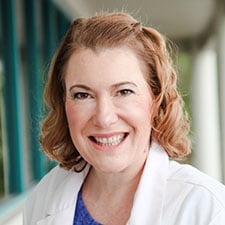Patients deserve care led by physicians—the most highly educated, trained and skilled health professionals, says Rebekah Bernard, MD, co-author of a book on the rise of NPs and PAs.
Advocating physician-led care teams and against the creep of scope-of-practice expansions is about protecting patients and providing safe and effective care, said Rebekah Bernard, MD, the daughter of two nurses.
“This is not an us-versus-them. This is a team-based approach,” said Dr. Bernard, an AMA member and family physician in Fort Myers, Florida, who co-wrote Patients at Risk: The Rise of the Nurse Practitioner and Physician Assistant in Healthcare, with Niran Al-Agba, MD, a pediatrician in Silverdale, Washington.
“We're all interested in the same thing—which is giving patients great quality care safely and cost effectively.” Dr. Bernard said during an episode of “AMA COVID-19 Update” in which she discussed the importance of physician-led care.
Fighting scope creep is a critical component of the AMA Recovery Plan for America’s Physicians.
Patients deserve care led by physicians—the most highly educated, trained and skilled health professionals. The AMA vigorously defends the practice of medicine against scope-of-practice expansions that threaten patient safety.
Education, training matter
The book details how care from nonphysicians is dangerously being promoted as “just as good” as that provided by doctors—despite the huge differences in education and training requirements.
Drs. Bernard and Al-Agba use the case of Alexus Ochoa-Dockins, a 19-year-old college athlete whose pulmonary embolism was overlooked by the family nurse practitioner (NP) in charge of her care in a hospital emergency department.
She died some 12 hours after later, and an Oklahoma jury awarded Alexus’ estate $6.19 million. The family’s attorney said that there was hope the verdict would lead to ensuring that “appropriately qualified medical providers” were on hand at all the state’s hospitals.
Unfortunately, this has not been the case. In the interview, Dr. Bernard cited research noting the unstandardized education and training that NPs receive and she adds that “nurse practice leaders and researchers have sounded the alarm that there is so much variability.”
In “Analysis of Nurse Practitioners’ Educational Preparation, Credentialing, and Scope of Practice in U.S. Emergency Departments,” a study by researchers from Johns Hopkins University, the University of New Mexico and other institutions, found that few NPs are certified to deliver emergency care and that NP qualifications to practice in emergency departments vary widely among states.
“No clear, uniform consensus exists regarding what is required for education, training and certification to work as an NP in an ED,” the researchers wrote in the study, published in January in the Journal of Nursing Regulation.
“Until this variability is resolved, we conclude that NPs should not perform independent, unsupervised care in the ED regardless of state law or hospital regulations in order to protect patient safety,” the study says.
A persuasive argument in scope-of-practice battles has been the differences in education and training.
Physicians complete between 10,000 and 16,000 hours of clinical education and training—four years in medical school and another three to seven years of residency training. By comparison, NPs complete between 500–720 hours of clinical training during two or three years of graduate-level education.
Good news on the state level
Encouraging developments are happening at the state level.
Dr. Bernard noted how the Florida Medical Association and Florida Academy of Family Physicians have launched a campaign called The Physician Decision that explains to patients the differences in training between physicians, NPs and PAs, and lets patients know they can request that a physician be put in charge of their care.
Also, Indiana and New Jersey (PDF) both passed transparency laws consistent with the AMA’s Truth in Advertising campaign, which is designed to ensure that health professionals clearly and honestly state their level of training, education and licensing.
A physician when needed
For Dr. Bernard, the scope of practice issue is driven by the fact that one day she may be in the need of the kind of high-quality physician-led care that patients like Ochoa-Dockins are denied.
“I'm going to be looking up from a gurney, and I'd like to know that there's going to be a physician there to take care of me,” she said. “If things don't change, there's a possibility that that won't be the case.”






